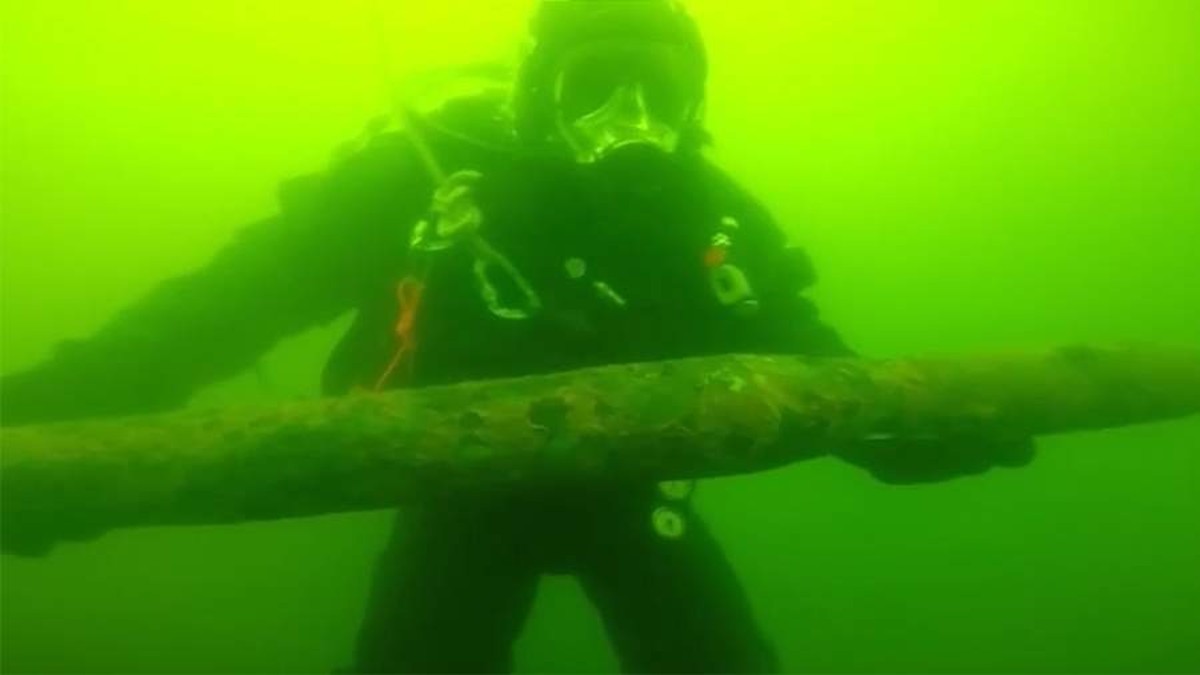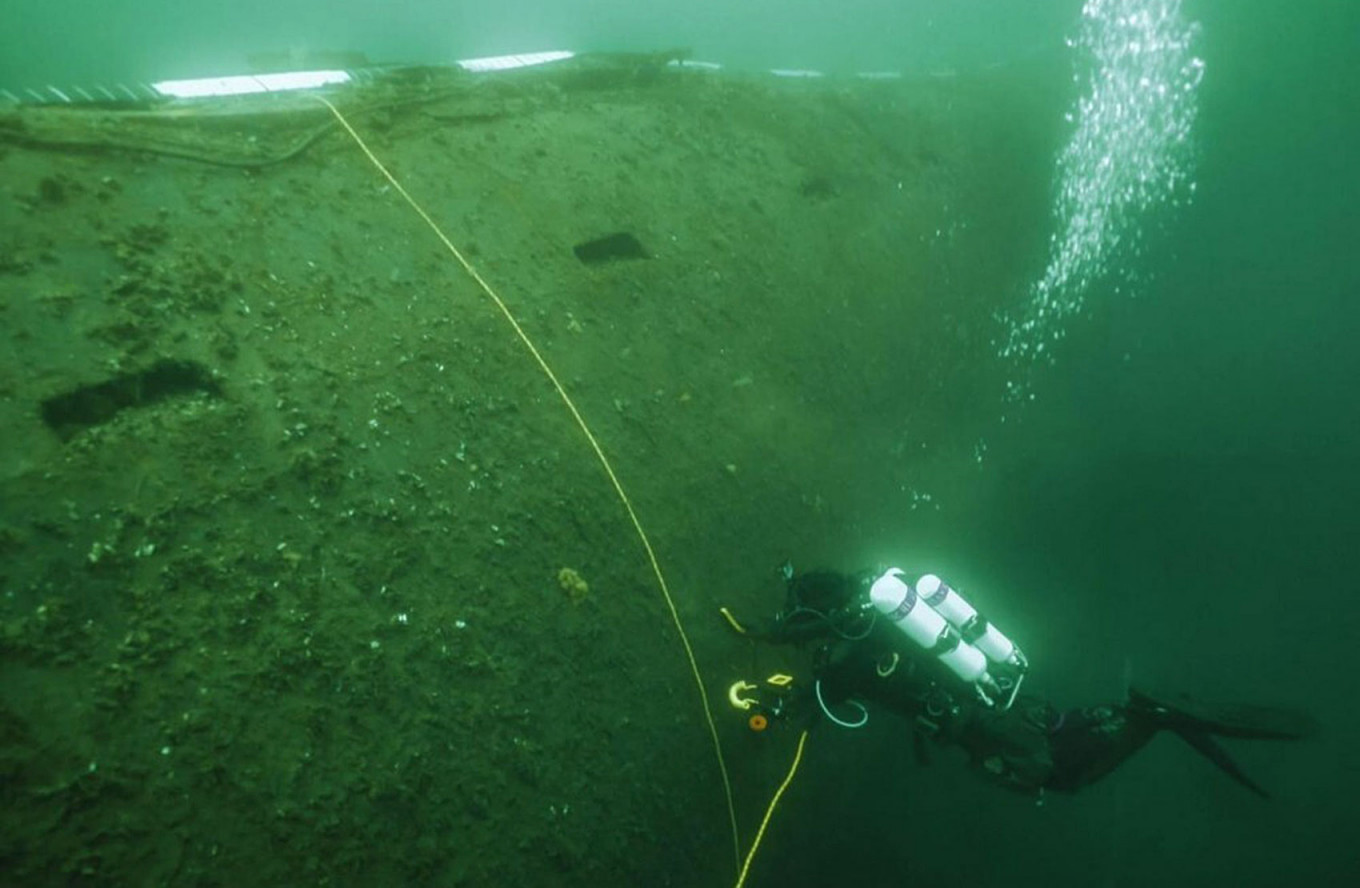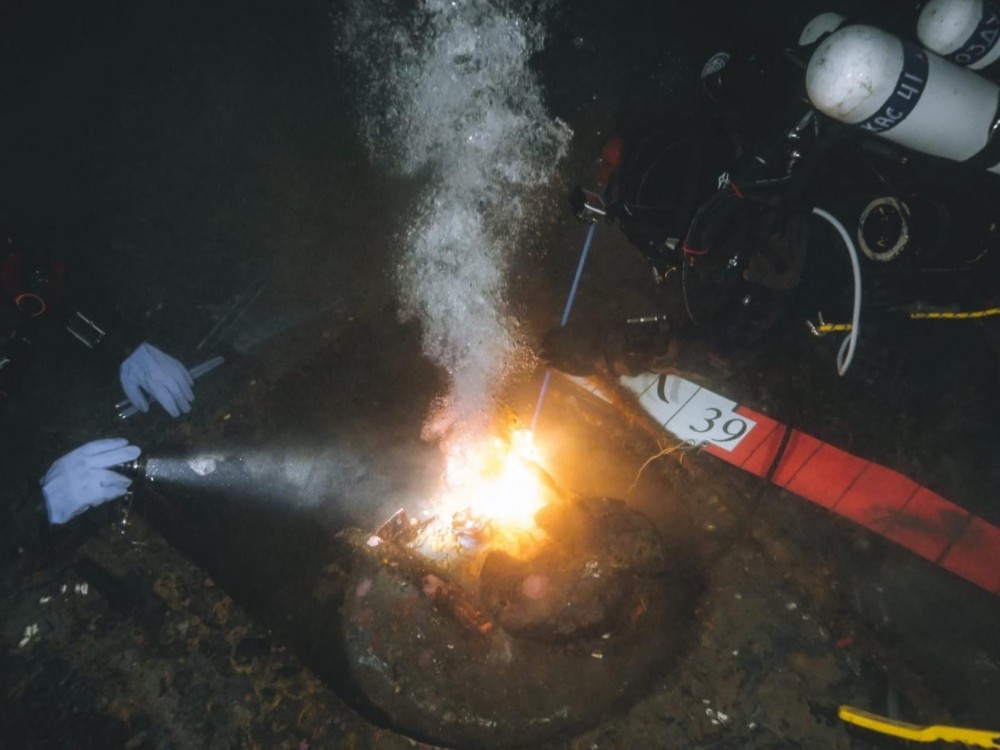The Ministry of Emergency Situations of the Russian Federation has announced that its divers are inspecting the K-27 nuclear submarine, which sank in the Kara Sea 42 years ago.
The announcement was made via the Ministry’s Telegram channel. It added that the vessel was located in Stepovoy Bay and was classified as a radiation-hazardous facility.
The Ministry stated that specialists were ready to conduct their inspections over the next month despite the challenges posed by low air and water temperatures as they assessed the submarine’s condition.
In a related effort, rescuers in the Kaliningrad region have been busy examining the hull of a World War II warship that sank near the Pioneer Resort.
The wreck, situated at a shallow depth in a popular recreational area, posed potential hazards. Emergency crews successfully raised dangerous elements from the ship’s structure and upper deck, although no explosive objects were confirmed during initial assessments.
The Ministry further mentioned that over the past five years, divers from the Ministry had recovered nearly 126,000 explosive items from various underwater sites, highlighting the ongoing risks associated with submerged military vessels.
KURSK: When Putin Played ‘Russian Roulette’ & Lost A Nuclear Submarine & Its 118 Crew Members
The K-27 Nuclear Submarine
In 1968, during the peak of the Cold War, the K-27 encountered a catastrophic event when radiation leaked from one of its reactors while navigating the Arctic. The incident resulted in the tragic loss of nine lives. The submarine was officially removed from the USSR Navy on February 1, 1979, before being sunk in 1982.
The ill-fated K-27, built on the November-class (Project 627 Kit) design, was the sole Project 645 nuclear attack submarine constructed by the Soviet Union.
The Soviets frequently sought cutting-edge technologies that were ahead of their time. With two VT-1 liquid-metal-cooled nuclear reactors on board, the K-27 functioned primarily as a scientific experiment, with operational capabilities being a secondary concern.
The K-27 was the first Soviet submarine to incorporate innovative lead-bismuth-cooled reactors. These reactors were designed to be smaller and more powerful than standard pressurized water reactors, but they faced significant operational challenges from the beginning.
The K-27 entered service in 1963, approximately five years after construction began. Its high costs and lengthy build time compared to other Soviet nuclear submarines earned it the nickname “Little Golden Fish”—or “Zolotaya Rybka” in Russian—after a magical fish from fairy tales that grants wishes.
The crew of this submarine belonged to the military elite and enjoyed luxuries like lemons and oranges, citrus fruits that were a rarity for most Soviet citizens struggling with daily shortages.
The crew was assured that the reactors were exceptionally safe and immune to the malfunctions that had affected some other Russian submarines in the past. However, the crew members often hesitated to enter the reactor compartment, but K-27’s Capt Pavel Leonov demonstrated its safety by sitting atop one of the reactors.
Exclusive: How Indian MiG-21s Thrashed F-15 Eagles During Military Drills, Shocking USAF Pilots
Regardless of these assurances, other crew members reported that radioactive particles had been detected on board the submarine from the very beginning.
Nonetheless, despite these difficulties, the K-27 achieved remarkable milestones during its service in the Soviet Navy, including the distinction of being the first Russian nuclear attack submarine to remain submerged for a continuous period of 50 days.

The Tragedy Of Soviet Nuclear Submarine K-27
Despite a somewhat impressive service record, the operational lifespan of the K-27 submarine was tragically brief. The vessel’s time on active duty came to an abrupt end due to a catastrophic reactor accident.
On May 24, 1968, a severe malfunction occurred in one of the submarine’s VT-1 reactors, leading to a dramatic power drop from 87 percent to a mere seven percent. This sudden decrease in output was accompanied by an alarming surge in gamma radiation that inundated the reactor compartment.
As the situation worsened, gas began to vent from the reactor, permeating other compartments of the submarine. Vyacheslav Mazurenko, a 22-year-old chief warrant officer at the time, later recalled the moment the gravity of the situation became apparent.
“We had a radiation detector in the compartment, but it was switched off. To be honest, we hadn’t paid much attention to the radiation dosimeters we were given,” he explained to the BBC.
“But then, our radiation supervisor switched on the detector in the compartment, and it went off the scale. He looked surprised and worried,” Mazurenko said.

Unfortunately, the crew did not grasp the full extent of the reactor’s failure until it was too late. Two hours after the initial alarm sounded, several crew members had to be physically carried out of the reactor compartment, suffering from severe radiation sickness.
Despite the dire circumstances, the crew managed to bring the beleaguered submarine to the surface. The journey back to Gremikha (Ostrovnoy) on Russia’s Kola Peninsula was a grueling one, taking over five hours.
“When the sub surfaced to make the trip back to the docks, the division ordered it to cut its engines and await special instructions,” Mazurenko recounted. “The captain [Pavel Leonov], however, decided to keep going because if the sub stopped for several hours, nobody would survive long enough to get it back to base.”
Tragically, every one of the 144 crew members was exposed to radiation, resulting in nine fatalities due to radiation poisoning linked to the incident. The K-27 was permanently removed from active duty in June 1968, although Soviet authorities carried out a range of experiments aboard until 1973.
The submarine was officially decommissioned in February 1979 and was later sunk in the Kara Sea on September 6, 1982, coming to rest at a depth of just 33 m (108 ft), near position 72°31’28″N., 55°30’09″E.
A Ticking “Nuclear Time Bomb”
Russian divers’ inspection of the K-27 submarine highlights Moscow’s worries regarding the substantial risks linked to the vessel. For years, Russian authorities have been exploring whether the sunken K-27 can be safely raised to remove the uranium from its reactors.
Moscow’s latest Arctic development plan includes ambitious initiatives aimed at retrieving various types of nuclear waste that were previously disposed of by the Soviet Union in the Barents and Kara Seas.
This plan aims to recover the K-27 and K-159 nuclear submarines by 2035. Due to their hazardous nature, both submarines present formidable challenges for cleanup efforts.
Combined, the K-27 and K-159 contain approximately one million curies of radiation—equivalent to about a quarter of the radiation released during the first month of the Fukushima disaster.
The K-27 was deemed too radioactive for conventional dismantling, so it was towed to the Arctic Novaya Zemlya nuclear testing range in 1982 and subsequently scuttled in one of the archipelago’s fjords.

The process of sinking the submarine to a depth of just 33 meters required considerable effort. The vessel was weighed down with asphalt to seal its fuel-filled reactors, and a hole was drilled into its aft ballast tank to facilitate the sinking.
However, this solution is not a long-term fix. The sealant around the reactor was intended only to prevent radiation leaks until 2032. Even more concerning is the potential for the K-27’s highly enriched fuel to trigger an uncontrolled nuclear chain reaction under certain conditions, posing a serious risk of localized radiation release.
In 2012, Radioactive Contamination experts explained to RT that their main challenge was to find a method for removing radioactive materials without causing too much disturbance to the reactors.
If the reactors are shaken excessively, this could lead to an uncontrolled chain reaction, which would significantly release radioactivity into the fragile Arctic marine environment.
Thomas Nilsen, editor of the Independent Barents Observer and former member of the Bellona Foundation, stated, “Radiation leakages will come sooner or later if we just leave the K-27 there. The sub has already been on the seafloor for 30 years, and it was rusty even before it was sunk. Leakages of radioactivity underwater are nearly impossible to clean up.”
The ambitious project to recover the K-27 and K-159 submarines is estimated to cost over 300 million euros (approximately $326 million).
This project had earlier garnered attention from the European Bank for Reconstruction and Development (EBRD), which, along with Norway and other European nations, was developing a feasibility study for this complex and technologically demanding retrieval operation.
However, the outbreak of the Ukraine war led the EBRD to suspend these considerations, resulting in minimal progress from Moscow on this front.
In September 2022, a group of Russian officials, engineers, and nuclear scientists convened to discuss ways to salvage the operation, but discussions were halted by a critical issue: Russia currently lacks the necessary technology to undertake such an operation.
A Dutch salvage vessel successfully recovered the Kursk submarine in 2001, but given the ongoing conflict in Ukraine, it is unlikely that the Netherlands would assist again.
This situation leaves the environmental conditions in the Russian Arctic in a precarious state, with unpredictable outcomes. Russia cannot navigate this challenge alone; global cooperation will be essential for addressing the pressing issue of nuclear waste recovery and ensuring the safety of the Arctic environment.
- Contact the author at ashishmichel(at)gmail.com
- Follow EurAsian Times on Google News




